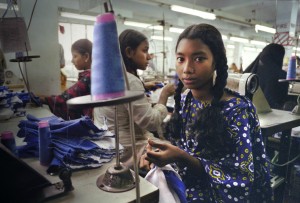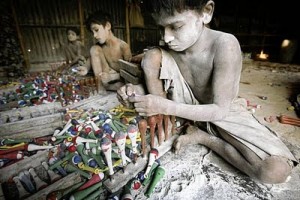
A young girl working in a sweatshop in Bangladesh
Watching The True Cost in class, it was definitely a very powerful and thought provoking documentary as it begged the question, who pays the price for our clothing? I was actually feeling very guilty myself while watching the documentary as I was wearing a shirt that I had purchased for $8 and was wondering just how much of that money went to the workers who made that shirt.
However, to critique the documentary, The True Cost did have a very strong point of view in saying that there are problems that exist within the current fashion industry, but perhaps put too much of the blame on companies for taking advantage of sweatshops and the people living in impoverish conditions. It’s easy to condemn the people who made comments in the video that said they don’t really think much about the poor working conditions in sweatshops and that the people could be doing much worse. But in reality, there is some truth to this as there are indeed worse jobs that people could be having like working in coal mines with even worse working conditions.
This brings me to an interesting article that I read from The Journal, a student newspaper at the University of Illinois. The article talks a bit about Dr.Benjamin Powell’s findings regarding sweatshops, and how there is a general misconception that sweatshops are extremely bad and should be abolished from existence. In reality, the people in these places honestly think that that is the best place to work for them, as they do earn more of a wage than other places, despite the poor working conditions and little to no vacation time.
What surprised me was that Dr. Powell conducted a questionnaire when visiting sweatshops and more than 50 percent of people said that they would not be willing to work for lower pay if the working conditions were improved.

unreal how people would rather have more wages over better working conditions
Overall, I think that there will always be some places in the world that are more impoverish than others and will have looser working regulations, and some companies will be trying to take advantage of these places as they want to be more profitable than their competitors. This is indeed a very big problem for our society, but it doesn’t just stop at consumers and companies, governments also have to be involved in the conversation. There needs to be more economic development in third-world countries and we all have to do their part in advocating for fair wages and safe working conditions for people worldwide.
It’s a bit disheartening to see that people would choose pay over better working conditions. We learn a lot about extrinsic and intrinsic motivators in our OB related Sauder courses. From what I recall, extrinsic motivators are much more effective at lower levels of income (higher wage = strong motivator), while intrinsic ones are at higher levels of income. This is so very observable in ‘True Cost’, and the article you are talking about. Even if sweatshops are the ‘better options’, it’s still sad to know that the economic conditions of these countries are in such bad states that the people living in them would choose this as a better option.
As someone mentioned in class as well, I noticed that the documentary did not focus as much on government’s role, and if there had been stricter regulations, maybe those building collapses would not have happened. However, one interviewee did also mention that the costs would simply just get displaced to make workers worse off yet again because of the fierce competition so I really don’t know about that solution either.
I completely agree, the True Cost was an eye opening experience, and I definitely left feeling a little guilty for anything I have previously purchased from any of these companies. Personally I feel as though I can make a difference by reflecting on each of my purchases, making sure that it is an article of clothing that will be with me for a long period of time, not simply worn once and thrown out. However, on the scope of bigger picture change I couldn’t even comprehend the start to a solution.
Perhaps the reality of these developing countries is that wages are already so minimal that they are barely making ends meet, in this way they are more willing to give up their personal safety then give up even a cent of their hard earned money. Reflecting that companies could consider setting up better living areas or perhaps day care centres for their workers, allowing them to save on the day to day expenses. In this way the companies could create some positive change to the employees lives without directly having to increase/decrease wages.
This of course would be a short term solution as society and governments work to create systematic change and more sustainable long term solutions.
Wow, that is quite interesting to note that people would choose better pay over better working conditions. Watching the documentary, I felt absolutely sick that I was indirectly supporting companies that treated their employees with such inhumanity. However, I agree with you, putting full blame on the companies who outsource their manufacturing is not the answer. I truly believe that we, the consumers, can be the change. These companies are making profit, through there logistical practices and we are encouraging it. Through our purchasing behaviour, we are indirectly helping these companies find success. There has got to be a better way to improve working conditions, without compromising pay. There is no easy solution, but it is clear to see that this industry is driven by customers. We have the power to say no, to support those who are using ethical business practices, and be willing to settle for a pieces of clothing that will last longer, but may cost more. Great post Garbriel!
In my other class there was a discussion about whether child labour and unsafe working conditions as well as whether it is justified. The discussion was around that if the workers didn’t work in these unsafe factories they would not be able to have jobs to support their family and due to the low wages they have to send their children to work in the sweat shops as well. When we see the problem it seems justified that they would want to have a job instead of no job. However, why do they get paid so less? What’s the root of the problem, and the reality is that companies are taking advantage of their situation. As companies bid and push the garment factory to offer a lower price or else they will withdraw their business, they are pushing the conditions to be poorer and the pay to be lower.